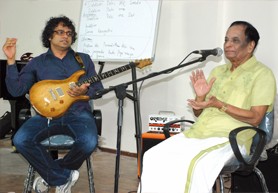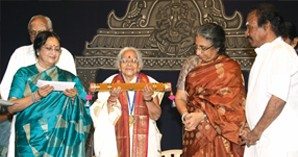SAVAL-JAVAB - A pedagogy for rhythm TRICHY SANKARAN SPOKE TO SHANKAR RAMACHANDRAN

The young college student from Trichy is also a disciple of mridanga maestro Palani Subramania Pillai. He travels frequently to accompany his guru at concerts with the major stalwarts of the time and makes a name for himself on the Carnatic concert stage. All the while he continues his studies, travelling with his textbooks and completes not just his Bachelors in 1964, but a Master’s degree as well in Economics from Vivekananda College in 1966.
Move the calendar forward to 2011. You email Professor Trichy Sankaran to add your message of congratulations to the myriad he must have received the day we all learned he had been selected Sangita Kalanidhi. Less than two hours later you have a reply thanking you. You marvel at the discipline it must take to respond to every message promptly on such a day.
Trichy Sankaran conversed with Sruti’s US correspondent after a concert in which he accompanied Chitravina Ravikiran at Columbus, Ohio. Excerpts from the interview:
What was your reaction on receiving news of the Sangita Kalanidhi award?
I received a call at 1.30 am from Mr. Murali, the president of the Music Academy. He was probably calling right after the meeting and the vote or even during the meeting. I told him I considered it my guru’s blessing.
Did you know you were being considered for the award?
I did not know I was considered this year, though I had been hearing for three years that I was in the top list.
NEW INITIATIVE - A music academy for the future MANNA SRINIVASAN

Young professional practitioners of Western music from across the globe coming to the bastion of Carnatic music for cross-cultural exchanges and upgrading their skills may sound like a ‘vivadi’ swara. The Swarnabhoomi Academy of Music (SAM), an initiative of the real estate outfit MARG as an integral component of the Knowledge Park at their township located about 75 kilometres from Chennai (see photo below), is just such an unlikely enterprise.
As SAM’s president, Prasanna, a well known guitarist who performs classical Carnatic music on the instrument, symbolises the institution’s motto: ‘Live Your Dreams’.
According to the academy’s brochure, SAM is the first professional college for contemporary music. Fully residential, it is designed and equipped to provide world class music education through six-month diploma programmes, workshops in music performance for vocal, guitar, bass, drums, piano and Indian percussion majors, with the engagement of rotating faculty of top class professional musicians from several countries with expertise in ‘every contemporary genre of music’. The curriculum seeks to integrate Indian classical and other world music traditions with contemporary jazz, rock and other Western music.
NEWS & NOTES - M.K. Saroja receives Natya Kalanidhi award RAJSHREE VASUDEVAN

The Natya Kalanidhi award was presented to M.K. Saroja, veteran Bharatanatyam exponent and guru, by Justice Prabha Sridevan on behalf of ABHAI (Association of Bharatanatyam Artistes of India), on the occasion of its 24th annual day on 27th November 2011, at the Sathguru Gnanananda Hall, in Chennai. Her petite and frail figure belied her numerous achievements read out as part of her citation. She was honoured with a medal, citation and a purse. A docu-film compiled by her son Ashish Mohan Khokar revealed the wide canvas she painted, be it nritta or abhinaya, under a demanding guru Kattumanarkoil Muthukumara Pillai. The humility behind the diligence and success was inspirational.
The title of Gaandharva Nipunaa and the Usha Srinivasan Endowment Award were presented to the versatile violinist and composer T.K. Padmanabhan. The Nirmala Ramachandran Endowment Award was presented to dancer and dance teacher Binesh Mahadevan, senior disciple of Ranganayaki Jayaraman.
Towards the ninth rasa VIDHYA SUBRAMANIAN
This is an exploration into the purported goal of Indian dance forms and their relevance to 21st century presenta-tions. The topic of my thesis for M.A. in Theatre Arts with a focus on Bharatanatyam was ‘Sringara and Bhakti – Relationship and Reciprocity in Twenty First Century Bharata Natyam’. It explored the mutuality between these two terms integral to our dance forms and their role in the attainment of the Indian classical dancer’s purported goal–the union between jeevatma and paramatma. As I began the cathartic process of writing, it gradually became evident that the goal needed to be re-defined.
Jeevatma-paramatma union = spiritual release, we all know.


